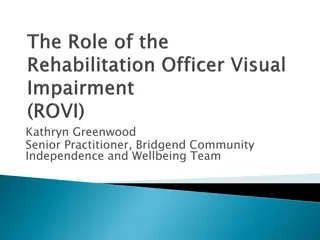Understanding Activities of Daily Living and Functional Independence
Activities of Daily Living (ADL) are essential tasks individuals perform daily for independent living. These tasks include self-maintenance, mobility, communication, and home management. ADLs are crucial indicators of a person's functional status, and the inability to perform them independently can lead to decreased quality of life. ADLs are classified into basic ADLs (BADL) and Instrumental Activities of Daily Living (IADLs), with each category encompassing specific skills necessary for personal independence.
Download Presentation

Please find below an Image/Link to download the presentation.
The content on the website is provided AS IS for your information and personal use only. It may not be sold, licensed, or shared on other websites without obtaining consent from the author. Download presentation by click this link. If you encounter any issues during the download, it is possible that the publisher has removed the file from their server.
E N D
Presentation Transcript
ACTIVITIES OF DAILY LIVING, FUNCTIONAL ASSESSMENT AND TRAINING OR FUNCTIONAL INDEPENDENCE Dr Digvijay Sharma School of health Sciences
The Activities of Daily Living are a series of basic activities performed by individuals on a daily basis necessary for independent living at home or in the community. ADL is used as an indicator of a person s functional status. The inability to perform ADLs results in the dependence of other individuals or mechanical devices. The inability to accomplish essential activities of daily living may lead to unsafe conditions and poor quality of life.
Activities of daily living (ADL)are tasks of self maintenance, mobility, communication and home management that enables an individual to achieve personal independence in his or her environment. The purpose of an ADL program is to train the patient to optimally perform, within the limit of his physical disabilities, all activities inherent to his daily life.
TYPES OF ADL The activities of daily living are classified into basic ADLs and Instrumental Activities of Daily Living (IADLs). The basic ADLs (BADL) or physical ADLs are those skills required to manage one s basic physical needs, including personal hygiene or grooming, dressing, toileting, transferring or ambulating, and eating. The Instrumental Activities of Daily Living (IADLs) include more complex activities related to the ability to live independently in the community. This would include activities such as e.g., managing finances and medications, food preparation, housekeeping, laundry.
BASIC ADLs The basic ADL include the following categories: Ambulating: The extent of an individual s ability to move from one position to another and walk independently. Feeding: The ability of a person to feed oneself. Dressing: The ability to select appropriate clothes and to put the clothes on. Personal hygiene: The ability to bathe and groom oneself and maintain dental hygiene, nail, and hair care. Continence: The ability to control bladder and bowel function Toileting: The ability to get to and from the toilet, using it appropriately, and cleaning oneself
INSTRUMENTAL ADLs The instrumental ADLs are those that require more complex thinking skills, including organizational skills. Transportation and shopping: Ability to procure groceries, attend events Managing transportation, either via driving or by organizing other means of transport. Managing finances: This includes the ability to pay bills and managing financial assets. Shopping and meal preparation, i.e., everything required to get a meal on the table. It also covers shopping for clothing and other items required for daily life.
Housecleaning and home maintenance: Cleaning kitchens after eating, maintaining living areas reasonably clean and tidy, and keeping up with home maintenance. Managing communication with others: The ability to manage telephone and mail. Managing medications: Ability to obtain medications and taking them as directed.
CAUSES FOR LIMITATIONS IN ADLs Aging is a natural process that may present a decline in the functional status of patients and is a common cause of subsequent loss of ADLs. Musculoskeletal, neurological, circulatory, or sensory conditions can lead to decreased physical function leading to impairment in ADLs. A cognitive or mental decline can also lead to impaired ADLs. Severe cognitive fluctuations in dementia patients have a significant association with impaired engagement in activities of daily living that negatively affect the quality of life.
Social isolation can lead to impairment in instrumental activities of daily living. Other factors such as side effects of medications, social isolation, or the patient's home environment can influence the ability to perform ADLs. Hospitalization and acute illnesses have also been associated with a decline in ADLs
MEASUREMENT OF ADLs BARTHEL S INDEX OF ACTIVITIES OF DAILY LIVING (BAI) MODIFIED BARTHEL SCORE FUNCTIONAL INDEPENDENCE MEASURES (FIM)
BARTHELS INDEX OF ACTIVITIES OF DAILY LIVING (BAI) The Barthel Index for activities of daily living was first published in 1965 by Barthel and Mahoney in the Maryland State Medical Journal. The scale s purpose is to measure performance and patient independence (or degree of assistance required) with respect to self-care, sphincter management, transfers and locomotion. Originally, the index was designed to be used in scoring improvement during rehabilitation of patients with chronic neuromuscular or musculoskeletal disorder and continues to be used so but has also been validated in studies on patient populations with: primary brain tumors and brain
The index should be used as a record of what a patient does, not as a record of what a patient could do. The index consists of 10 items (scored in increments of 5 points) that relate to activities of daily living (ADLs) and is calculated by summing the response value to each of these items.
Result interpretation The Barthel Index measures functional disability in 10 ADLs by quantifying patient performance. 5-point increments are used in scoring, with a maximal score of 100 indicating full independence in physical functioning whilst a lowest score of 0 indicating a patient with a complete bed-bound state. The higher the score following the Barthel Index assessment, the greater the likelihood for the patient to be able to live at home, independently, with varying degrees of help and care, following discharge from hospital.
MODIFIED BARTHEL SCORE Modified Barthel Index extends the original form to 15-items to include eating and drinking (either as separate items) or merged together
FUNCTIONAL INDEPENDENCE MEASURES (FIM) A broad based measurement of function, which is used by rehabilitation centers, is the Functional Independence Measure (FIM), a chart that consists of 18 categories of function sub grouped under Self care Mobility locomotion Sphincter control Communication Social cognition Each components scored on a scale from 1 (dependent) to 7 (independent). Overall scores may range from 18 (totally dependent) to 126 (totally independent).
ADL TRAINING The therapists should estimate which ADLs are possible and which are impossible for the patient to achieve. He should explore the use of alternate methods of performing the activities and the use of assistive devices. In order to motivate the patient the objectives are framed with a short and long term perspective The training program may be graded by beginning with a few simple tasks and gradually increasing their number and complexity. The methods of teaching the patient to perform daily living tasks must be tailored to suit each patient s learning style and ability.
Patient who have perceptual problems, poor memory, and difficulty following instructions of any kind will require a more concrete, step by step approach which is easy to comprehend. Before beginning training in any ADL the therapists must begin be providing adequate space and arrange equipment and furniture for convenience and safety. Architectural barriers must be removed at home and office. Performance is modified and corrected as needed and the process is repeated to ensure skilled performance.
Dressing Training Upper Limb Dressing: The neck has to be stable on the shoulder girdle The muscle strength in the upper limb should be 3/5 to 4/5. The range of movement at the shoulder must be at least 0-90 degree of flexion/abduction, 0-30 degree of medial or lateral rotation, and 15-140 degree elbow flexion. Sitting balance without support in bed and wheelchair. Ability to use buttons or fasteners. A flexor hinge hand splint may be used if the patient has good wrist extensor power.
Lower Limb Dressing: The trainer, usually a physiotherapist enhances the muscle strength and ensures the extent of movement at the knee and hip that must permit the person to sit with legs fully stretched and reach out to his calf. Generally a range of 0-120 degrees would be adequate. Body control, such as ability to transfer from bed to wheelchair with minimum assistance rolling from side to side, or balance when lying on side, must be developed. If patient has spasms and can control them, they are used to his advantage to flex and extend the lower
Clothing Recommendations Clothing should be loose and have front fastenings. Zippers or Velcro fasteners are preferred to buttons. Since patients often use the thumb to fasten zippers, loops are recommended. Shoes should be carefully selected so as to provide foot stability during patient transfer.
Hygiene and Grooming Adaptations: A brush with grip is used for bathing or shampooing hair. A bath brush is provided with a long handle to reach behind the back A position-adjustable hair dryer. A long handled toothbrush, lipstick applier or razor. A short reacher Dressing sticks to enable the person to pull on clothes. The bathtub can have safety rails, and extended or built up handles on faucets.
Environmental Adaptations When you cannot change the patient, change the environment . If a patient with rheumatoid arthritis repeatedly comes to the department saying that she cannot open the tap, it is far easier to change the tap than to keep strengthening her grip.
Communication Adaptations A vast array of adaptations are improvised to keep pace with the revolution in communication. Adaptations to the computer and keyboard. Telephones should be placed within easy reach. A clip type receiver, a dialing stick or push button phone may make usage of the phone easier. Built up pens and pencils with an easier grip.
Some Home Management Tips Store frequently used items on the lower shelves of the cabinet. Sit on a high stool to work comfortably. Use a reacher to get items beyond your reach. Stabilize mixing bowls and dishes or vegetables with some aid. Use lightweight utensils, and where possible and safe use powered can openers and mixers. Use long handled taps and a top loading automatic washer and an adjustable ironing board.
Problems Encountered During ADL Training The general health condition (apart from the disability), like respiratory infection, cardiac problems or diabetes which can inhibit ADL training, are regularly monitored. Daily checks must be carried out for pressure sores. Any pain in neck or trunk that persists when attempting training can interfere with activities of daily living. Affordability is another question, with most of the population in India unable to even buy a good wheelchair, let alone sophisticated items like an environment control system or a motorized wheelchair.
REFERENCES S Sunder. Textbook of rehabilitation.2010;3:232-244. Peter F, Deb L, Sukumaran S; Shoshana B. Activities of daily living. 2021.
THANK YOU

























